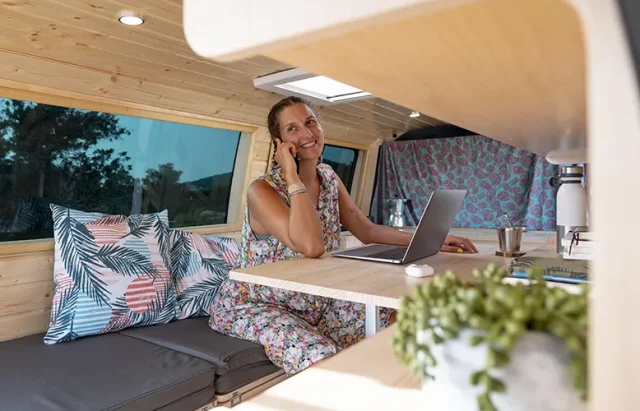
Picture this: you’re crammed into your tiny camper, laptop balanced precariously on your knees, trying to join a video call while the neighbor’s generator drowns out your voice. Your back is killing you, your phone has no signal, and you’re starting to question this whole “work from anywhere” dream.
I’ve been there. The romanticized vision of working from scenic locations while living the van life doesn’t always match reality – especially when your “office” is a space smaller than most people’s bathrooms.
But here’s what I’ve learned after two years of remote work on the road: with the right setup, any camper can become a productivity powerhouse that rivals traditional offices. The key is working smarter, not harder, and making every square inch count.
1. Design a Dedicated Workspace Zone
The biggest mistake most people make is trying to work from their bed or dinette without any real workspace strategy.
Even in the smallest camper, you need a designated work zone that signals “this is where business happens.” This doesn’t mean sacrificing your entire living space – it means getting creative with multi-functional solutions.
Consider a fold-down desk that doubles as storage, or a swivel chair that serves both your dinette and office needs. Custom van conversions often include brilliant space-saving office solutions that can inspire your own setup, even in an existing camper.
The psychological benefit of a dedicated workspace cannot be overstated. When you sit in that specific spot, your brain shifts into work mode. When you pack it away, you’re officially off duty.
2. Master Your Power Management
Nothing kills productivity faster than a dead laptop battery during an important call. Your power strategy needs to be bulletproof, with multiple backup plans.
Solar panels are the gold standard for sustained power, but they’re not magic. Calculate your actual power consumption: laptop, phone, router, lights, and any cooling/heating needs. Most people drastically underestimate their power needs and end up frustrated.
Consider a three-tier approach: solar for daily charging, a generator for heavy power days, and shore power when available. A quality inverter and sufficient battery bank (think lithium for space efficiency) form the backbone of your mobile office infrastructure.
Don’t forget about device management – a good laptop with 8+ hour battery life makes all the difference between a productive day and constant anxiety about finding power.
3. Solve Connectivity Like a Pro
Internet connectivity can make or break your mobile office experience. Here’s your multi-layered approach to staying connected:
- Primary connection: Unlimited data plan with a reliable carrier that has good coverage in your travel areas
- Backup connection: Secondary carrier with different network (Verizon + AT&T combo works well)
- Signal enhancement: External antenna and cellular booster to maximize weak signals in remote areas
- Emergency backup: Satellite internet device for truly off-grid situations
- Data management: Offline-capable apps and cloud sync during high-signal windows
Remote work productivity improves dramatically when you’re not constantly worried about losing connection mid-meeting.
4. Climate Control and Comfort
Temperature extremes are productivity killers. You can’t focus when you’re sweating through a heat wave or shivering in unexpected cold snaps.
Proper ventilation is crucial – two-way airflow prevents that stuffy, brain-fog feeling that kills creativity. Roof fans, window vents, and strategic positioning can create comfortable airflow without running power-hungry air conditioning constantly.
For heating, efficient options like diesel heaters provide steady warmth without depleting your battery bank. In extreme heat, consider portable air conditioning units powered by larger battery systems, or plan your work hours for cooler parts of the day.
Ergonomics matter more in small spaces. A proper ergonomic chair might seem like a luxury, but it’s an investment in your ability to work productively for hours without pain.
5. Smart Storage and Organization
Clutter is the enemy of productivity, especially in small spaces. Everything needs a designated home, and your setup should allow for quick deployment and pack-away.
Maximize vertical space with wall-mounted monitors, shelving systems, and cable management solutions. Battery-powered portable fridges and other essential appliances should integrate seamlessly into your workspace flow.
Create systems where your office setup doesn’t interfere with daily living. Slide-out desk drawers, magnetic strips for small items, and modular storage containers keep everything organized without permanent installation.
The goal is reaching a point where setting up your office takes under five minutes and packing it away is just as quick.
6. Lighting That Actually Works
Poor lighting leads to eye strain, headaches, and decreased productivity – problems that are amplified in small spaces with limited window options.
Maximize natural light by positioning your workspace near the largest windows, but avoid direct sun that creates screen glare. LED task lighting should be adjustable and positioned to eliminate shadows on your work surface.
Consider the color temperature of your lighting – cooler temperatures (5000K-6500K) promote alertness during work hours, while warmer light (2700K-3000K) helps you wind down in the evening.
7. Create Boundaries and Routines
The biggest challenge of mobile office life isn’t technical – it’s psychological. Without clear boundaries, work expands to fill all available time and space.
Establish non-negotiable routines that create structure:
- Morning ritual: Coffee, check weather/route, then work setup
- Work hours: Define start/stop times and stick to them religiously
- Break protocols: Step outside every hour, even if just for five minutes
- End-of-day routine: Pack away work materials completely
- Weekend boundaries: Resist the urge to “just check email” on rest days
Physical cues help maintain professional presence during video calls. A backdrop, good lighting, and treating video calls with the same seriousness as in-person meetings goes a long way.
The Freedom to Work Anywhere
Transforming your camper into a mobile office isn’t just about productivity – it’s about redesigning your relationship with work entirely. When your office can move to mountain views, seaside cliffs, or desert sunsets, work becomes part of the adventure rather than something that prevents it.
The initial setup investment pays dividends in flexibility, reduced overhead costs, and life experiences that no traditional office can provide. With these seven strategies, you’re not just surviving the mobile office lifestyle – you’re thriving in it.





